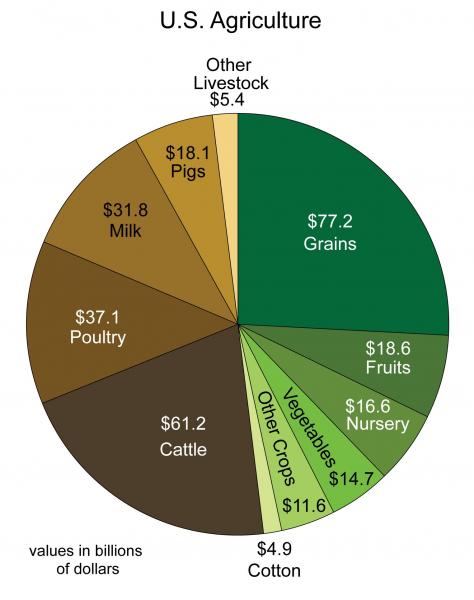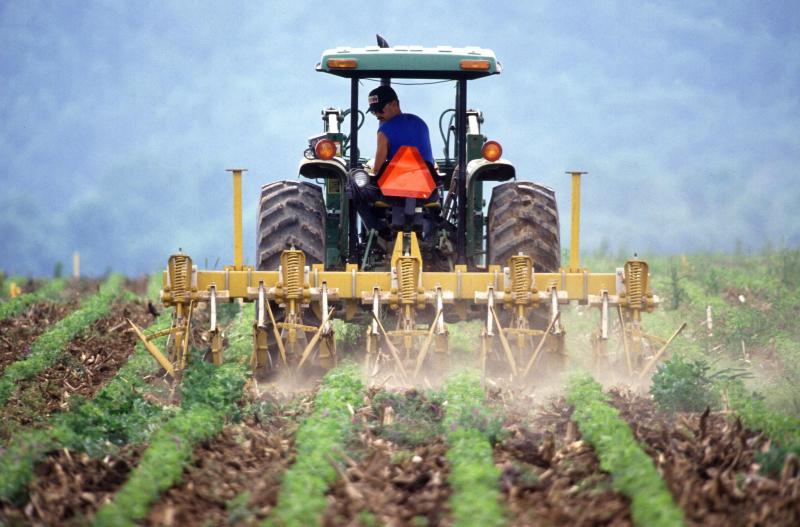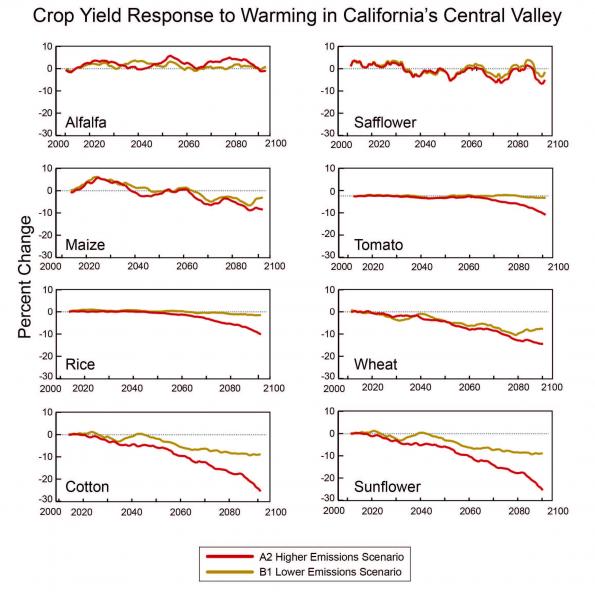Food Production
Agriculture in the United States currently produces approximately $300 billion a year in commodities, with livestock accounting for roughly half the value in 2012.1 Agricultural production has always been affected by climate and weather variability, and American farmers have adopted production practices appropriate to their local environmental conditions and resource availability.2 The climate and weather patterns that have historically shaped U.S. agricultural production, however, are changing. Projected changes in climate over the next century have the potential to transform American agriculture, particularly for production systems at the marginal climate ranges, such as drought-prone areas in the Southwest.1
Climate change poses new challenges for crop and livestock production in America. By 2050, average global temperature is projected to be between 1.8°F and 5.4°F higher and precipitation extremes will be more intense.3 Consequently, yields of major U.S. crops and farm profits are expected to decline.3 California’s warm and dry Central Valley, for example, is predicted to see a decrease in productivity for most crops because of warmer temperatures3
Warmer temperatures are also expected to put physiological stress on livestock animals, decreasing productivity of meat, milk, and eggs.3 More intense, frequent, and longer-lasting heat waves expected with climate change pose threats to outdoor and indoor livestock operations. The potential harm is exemplified by the deaths of thousands of cattle and poultry during past heat wave events.4
Precipitation plays an important role as well and interacts with temperature to influence productivity. In general, wetter areas are expected to get wetter and drier areas are expected to get drier with climate change.3 The 2012 drought impacted 80 percent of U.S. agricultural land, the most extensive since the 1950s.5 In 2014, California experienced its third driest year on record, representing a statewide loss of $2.2 billion in crop, livestock, and dairy production, water pumping costs, and jobs lost.6 Too much or too little rain threatens the health of crops and livestock. Floods also impact long-term agricultural productivity by increasing erosion.
Some species of weeds, diseases, and insects will thrive as climate changes. Geographic temperature and moisture shifts may allow pest species to shift their ranges and expand their populations, forcing producers to cope with new biological stresses on their operations.3
To learn more about regional food production vulnerabilities to climate and weather, and tools for adaptation, visit climatehubs.oce.usda.gov.
- 1a1bWalthall, C.L., J. Hatfield, P. Backlund, L. Lengnick, E. Marshall, M. Walsh, S. Adkins, M. Aillery, E.A. Ainsworth, C. Ammann, C.J. Anderson, I. Bartomeus, L.H. Baumgard, F. Booker, B. Bradley, D.M. Blumenthal, J. Bunce, K. Burkey, S.M. Dabney, J.A. Delgado, J. Dukes, A. Funk, K. Garrett, M. Glenn, D.A. Grantz, D. Goodrich, S. Hu, R.C. Izaurralde, R.A.C. Jones, S-H. Kim, A.D.B. Leaky, K. Lewers, T.L. Mader, A. McClung, J. Morgan, D.J. Muth, M. Nearing, D.M. Oosterhuis, D. Ort, C. Parmesan, W.T. Pettigrew, W. Polley, R. Rader, C. Rice, M. Rivington, E. Rosskopf, W.A. Salas, L.E. Sollenberger, R. Srygley, C. Stöckle, E.S. Takle, D. Timlin, J.W. White, R. Winfree, L. Wright-Morton, and L.H. Ziska, 2012: Climate Change and Agriculture in the United States: Effects and Adaptation, USDA Technical Bulletin 1935, 186 pp.
- 2Malcolm, S., E. Marshall, M. Aillery, P. Heisey, M. Livingston, and K. Day-Rubenstein, 2012: Agricultural Adaptation to a Changing Climate: Economic and Environmental Implications Vary by U.S. Region, ERR-136, U.S. Department of Agriculture, Economic Research Service, 76 pp.
- 3a3b3c3d3e3fHatfield, J., G. Takle, R. Grotjahn, P. Holden, R.C. Izaurralde, T. Mader, E. Marshall, and D. Liverman, 2014: Ch. 6: Agriculture. Climate Change Impacts in the United States: The Third National Climate Assessment, J.M. Melillo, Terese (T.C.) Richmond, and G.W. Yohe, Eds., U.S. Global Change Research Program, 150-174. doi:10.7930/J02Z13FR.
- 4Nienabar, J.A., and G. L. Hahn, 2007: Livestock production system management responses to thermal challenges. Int. J. Biometeorol., 52, 149–157, doi:10.1007/s00484-007-0103-x.
- 5U.S. Department of Agriculture Economic Research Service, posted July 26, 2013: U.S. Drought 2012: Farm and Food Impacts.
- 6Howitt, R.E., J. Medellin-Azuara, D. MacEwan, J.R. Lund, and D.A. Sumner, 2014: Economic Analysis of the 2014 Drought for California Agriculture. Center for Watershed Sciences, University of California, Davis. 20 pp.; University of California, Davis, posted July 15, 2014: Drought impact study: California agriculture faces greatest water loss ever seen.




